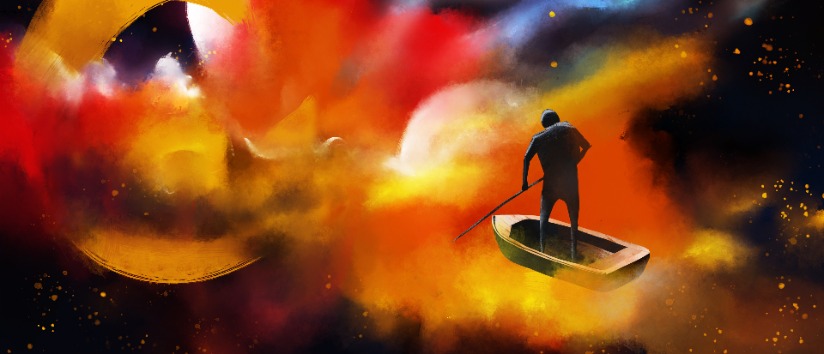My psychiatric condition helped me discover my genderfluidity
29 July 2020
As far back as I can remember, I've always felt like I was a boy who dressed like a girl.
Maladaptive Daydreaming (MD) is a psychiatric condition discovered in 2002 by Professor Eliezer Somer at the University of Haifa, Israel. MD is a defence mechanism, a dissociative absorption. Our triggers are actual events from which our brains will protect us by conjuring up other situations to take us out of the present.
"I believe that MD often appears in the lives of underrepresented voices. The social ignorance of the condition creates, almost ironically, a vicious cycle".
To this day it is diagnostically non-existent which leads us, the sufferers, to feel unrepresented. The lack of support shapes our invisibility. Self-diagnosis, in most cases, is the sole rescuer. There aren't many psychiatric conditions out there that involve utter addiction to daydreaming or tendency to converse with characters that are neither present nor existent. The attributes of MD are distinctive too. There's the pacing; the need for musical stimulation; a consistent soundtrack or dialogue; the mouthing; the whispering; and the vividness of emotions that daydreaming procures, to name a few.
Discovering my genderfluidity
It's been six months since my denial ended and the nightmarish deficiency to get proper help has urged me to make a life-changing decision - to help myself.
My daydreaming has adapted to this commitment. Now, my daydreams are centred around the reason for the very existence of MD in my life.
My MD helped me to discover my genderfluidity after watching an episode of RuPaul's Drag Race and listening to Gigi Goode coming out as genderfluid. I instantly thought about these characters I have been trying to incorporate into my life since I entered my teenage years; India, Sandi, and Jim were fabulously fluid and I have spent time and tremendous energy trying to become them. Yet, I had no idea I myself could possibly be genderfluid.
One night I sat on my bed and, along with the non-existent personas, I remembered. I recalled the struggle to belong - to anyone, to anything, and anywhere. I would act - be - the personas I imagined rather than myself. This wasn't linked to the lack of affection I was receiving it was connected to their looks and their very being. My daydreaming universe was set around music. I would spend a significant amount of time and energy creating musicians including their physique and also their music. Playlists started to invade my phone. My characters have always been androgynous men. I'd give them female singers, simply because it was the way I saw them. Mentally I was them. They were what I wanted to be.
"Addiction got the best of me"
Suddenly, after leaving high school, I was allowed to daydream more. In other words, addiction got the best of me. I started to see a psychiatrist once a week and since MD isn't recognised, I wasn't diagnosed. My mother told her what I did in my room and the psychiatrist called me a "dreamer".
Soon after, I reconnected with an old friend who took me out with him one night and unwittingly changed my life forever. I arrived in the LGBTQI+ world, a place where being something only matters to oneself. I explored my gender and a couple of years later began to live as this genderfluid being without having the language to describe it.
Dysphoria
The character Sandi Carmen Carlton was the first persona I created who represented me. She had an anatomically male torso and, below, she had female anatomy. For a few months I considered proceeding with the surgery to actually get this torso. To become this in-between, I had to change my physical appearance. At least, that's what I thought.
When I finally gave up on this idea I believed this was just a phase and resigned myself to becoming a feminine woman. This seemed like the only choice. Yet the reflection in the mirror was confusing. I saw many things and I've never been able to see only a woman... there was more. Five years later I finally know - and I am blessed to be aware of - my genderfluidity.
The excitement in my voice upon sharing my genderfluidity with loved ones was gratitude. There is a name for it! I'm not just a "freak" who goes through weird phases.
Gender fluidity and my mental health
Not knowing about genderfluidity or MD has profoundly affected my mental health.
Each time I’d observe other girls I was met with a barrage of intrusive thoughts. It was a strange time. Unworthiness was my closest ally. Necessarily, my MD worsened. Becoming someone else had a price I was willing to pay. Out there, I didn’t feel represented. Romantic relationships are still non-existent in my life. As a straight woman, I thought my other side was considered repellent to men. These thoughts are the exacts triggers of mental illness.
Based on my experience with it today, I believe that MD often appears in the lives of underrepresented voices. The social ignorance of the condition creates, almost ironically, a vicious cycle.
What frightens me today is how others who are living like me aren't aware of its existence as a condition. MD may reduce at some point. Still, from experience, I can assure you that all it needs is an obstacle. The goals, actual dreams, and most importantly, self-esteem reduces until the next wake up call happens.
- See more: Maladaptive Daydreaming: the underrepresented condition
- See more: "No one should be shamed for trying to understand what is affecting them": A defence of self-diagnosis
Genderfluidity is about being - it isn't just about looks. To accept one another we must release expectations. This is still a work in progress for me but I'm hopeful. I am supported by others and I am allowed to share. My pronouns haven't changed either - neither because I'm scared nor lazy. The masculine aspect in me wants to be a she. I see myself in my daydreams, which is relatively new, and this person isn't different, isn't in another time, it's just me. I've got control, and that's all that matters.
Today, I proudly identify as genderfluid. It is personal. I don't often feel the need to speak about it. I wrote this because the more we share, the more we're seen. This isn't for me, it's for MD and genderfluidity. It's for those underrepresented voices.


Comments
Write a Comment
Comment Submitted